Infrared regularization with vector mesons and baryons
粒子群优化算法及其在背包问题中的应用【精品文档】(完整版)

摘要背包问题属于NP难问题,解决背包问题是解决组合优化所面临的问题之一,在现实中有着广泛的应用背景,而粒子群算法作为群智能算法而言,它通过追随当前搜索到的最优值来寻找全局最优。
本文在对背包问题进行研究分析的基础上,采用基本粒子群算法、带惯性权重和带收缩因子的改进型粒子群算法来分别解决两个三十维和十维的0/1背包问题,通过多次试验,最终得出了所给的背包问题的最优解,与已知问题最优解一致。
关键词:粒子群优化算法,智能算法,背包问题,最优化AbstractKnapsack problem is NP-hard problem to solve the knapsack problem solving combinatorial optimization problems faced by one of the wide range of applications in the real background, while the particle swarm algorithm as a swarm intelligence algorithm, by following the current search for the optimal.The value to find the global optimum. Based on the analysis of the knapsack problem, using the particle swarm algorithm with inertia weight and with a shrinkage factor improved particle swarm optimization to solve the two thirty-dimensional and eleven-dimensional 0/1 knapsack problem, through a multi-trials, and ultimately obtained the optimal solution to the knapsack problem with known optimal solution consistent.Keywords: Particle swarm optimization algorithm, the intelligent algorithm, knapsack problem, optimization,目录1 绪论 (1)1.1组合优化问题 (1)1.2背包问题 (1)1.3对背包问题的研究 (2)1.4本文的结构 (4)2 优化算法和背包问题 (5)2.1粒子群算法 (6)2.2背包问题 (7)2.3本章小结 (9)3 基本粒子群算法在背包问题中的应用 (10)3.1基本粒子群算法 (10)3.2基于基本粒子群算法的背包问题 (11)3.3本章小结 (21)4 基于改进型粒子群算法的背包问题 (22)4.1引入惯性权重与收缩因子的改进型粒子群算法 (22)4.2基于改进型粒子群算法的背包问题 (24)4.3本章小结 (28)5 总结与展望 (29)5.1本文总结 (29)5.2展望 (29)参考文献 (30)致谢 .......................................错误!未定义书签。
随机傅里叶特征映射
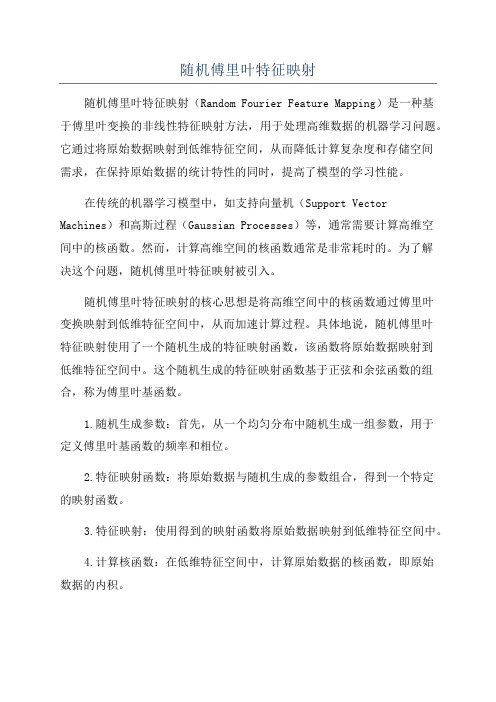
随机傅里叶特征映射随机傅里叶特征映射(Random Fourier Feature Mapping)是一种基于傅里叶变换的非线性特征映射方法,用于处理高维数据的机器学习问题。
它通过将原始数据映射到低维特征空间,从而降低计算复杂度和存储空间需求,在保持原始数据的统计特性的同时,提高了模型的学习性能。
在传统的机器学习模型中,如支持向量机(Support Vector Machines)和高斯过程(Gaussian Processes)等,通常需要计算高维空间中的核函数。
然而,计算高维空间的核函数通常是非常耗时的。
为了解决这个问题,随机傅里叶特征映射被引入。
随机傅里叶特征映射的核心思想是将高维空间中的核函数通过傅里叶变换映射到低维特征空间中,从而加速计算过程。
具体地说,随机傅里叶特征映射使用了一个随机生成的特征映射函数,该函数将原始数据映射到低维特征空间中。
这个随机生成的特征映射函数基于正弦和余弦函数的组合,称为傅里叶基函数。
1.随机生成参数:首先,从一个均匀分布中随机生成一组参数,用于定义傅里叶基函数的频率和相位。
2.特征映射函数:将原始数据与随机生成的参数组合,得到一个特定的映射函数。
3.特征映射:使用得到的映射函数将原始数据映射到低维特征空间中。
4.计算核函数:在低维特征空间中,计算原始数据的核函数,即原始数据的内积。
随机傅里叶特征映射有几个优点。
首先,它能够将高维空间中的核函数映射到低维特征空间中,从而显著降低计算复杂度。
其次,它不需要存储高维空间中的核函数,因此节省了存储空间。
此外,它能够保持数据的统计特性,使得模型在低维特征空间中具有相似的学习性能。
然而,随机傅里叶特征映射也有一些限制。
首先,它依赖于随机生成的参数,因此每次运行结果可能会有所不同。
其次,映射到低维特征空间后,模型可能会出现一些近似误差,这取决于所选择的映射函数和参数。
随机傅里叶特征映射已经被广泛应用于各种机器学习问题中,包括文本分类、图像识别和语音识别等。
基于自适应对偶字典的磁共振图像的超分辨率重建
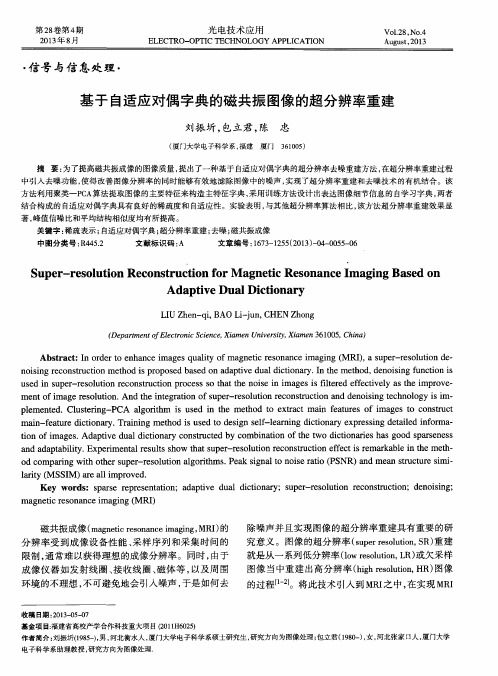
L I U Z h e n - q i , B A 0 L i - j u n , C HE N Z h o n g
r De p a r t m e n t o f E l e c t r o n i c S c i e n c e , X i a me n U n i v e r s i t y , Xi a me n 3 6 1 0 0 5 , C h i n a )
刘振 圻 , 包立君 , 陈 忠
( 厦 门大学电子科 学系, 福建 厦门 3 6 1 0 0 5 )
摘 要: 为了提高磁共振成像的图像 质量 , 提 出了一种基于 自适应对偶字典的超分辨率 去噪重建方法 , 在超分辨率重建过程 中引入去噪功能 , 使 得改善图像 分辨率的同时能够有效地滤除 图像 中的噪声 , 实现 了超分辨率重建和去噪技术 的有机结合 。该 方法利用聚类一P c A算 法提取图像的主要特征来构造主特征字典 , 采用 训练方法设计 出表达图像 细节信 息的 自学 习字 典 , 两者 结合构成的 自适应对偶字典具有 良好 的稀疏度和 自适应性 。实验表 明, 与其他超分辨率算法相 比, 该方法超分辨率重建效果显 著, 峰值信噪 比和平均结构相似度均有所提高。
第2 8 卷第 4 期
2 0 1 3 年8 月
பைடு நூலகம்光 电技术 应 用
EL ECT RO一 0P T I C T ECHNOLOGY AP P LI CAT1 0N
V O1 . 28. NO. 4
Au g u s t , 2 01 3
・
信号 与信息处理 ・
基 于 自适应对偶 字典的磁共振 图像 的超 分辨率重建
最大似然法精确重构不同状态混沌激光的相空间分布

最大似然法精确重构不同状态混沌激光的相空间分布下载提示:该文档是本店铺精心编制而成的,希望大家下载后,能够帮助大家解决实际问题。
文档下载后可定制修改,请根据实际需要进行调整和使用,谢谢!本店铺为大家提供各种类型的实用资料,如教育随笔、日记赏析、句子摘抄、古诗大全、经典美文、话题作文、工作总结、词语解析、文案摘录、其他资料等等,想了解不同资料格式和写法,敬请关注!Download tips: This document is carefully compiled by this editor. I hope that after you download it, it can help you solve practical problems. The document can be customized and modified after downloading, please adjust and use it according to actual needs, thank you! In addition, this shop provides you with various types of practical materials, such as educational essays, diary appreciation, sentence excerpts, ancient poems, classic articles, topic composition, work summary, word parsing, copy excerpts, other materials and so on, want to know different data formats and writing methods, please pay attention!最大似然法精确重构不同状态混沌激光的相空间分布引言混沌现象在自然界中广泛存在,而混沌激光的相空间分布研究对于理解混沌系统的动力学行为至关重要。
外文翻译---基于离散混沌映射的图像加密并行算法

3.转换
3.1.A-转换
在A转换中,A代表加,能被形式化的定义如下:
a+b=c(1)
加法被定义为按位与操作
转换A有三个基本性质:
(2.1)a+a=0
(2.2)a+b=b+a(2)
(2.3)(a+b)+c=a+(b+c)
在并行模式计算时,许多的PE可以同时读取或写入相同的内存区域(即临界区),
这往往会导致意想不到的执行程序。因此,有必要在关键区域使用一些并行技术管理。
2.2.并行图像的加密框架
为了满足上述要求,我们提出了一个并行图像加密的框架,这是一个四个步骤的过程:
步骤1:整个图像被划分成若干块。
步骤2:每个PE负责确定数量块。一个区域内的像素可以充分使用有效的混乱和扩散进行操作加密。
附件C:译文
基于离散混沌映射的图像加密并行算法
摘要:
最近,针对图像加密提出了多种基于混沌的算法。然而,它们都无法在并行计算环境中有效工作。在本文中,我们提出了一个并行图像加密的框架。基于此框架内,一个使用离散柯尔莫哥洛夫流映射的新算法被提出。它符合所有并行图像加密算法的要求。此外,它是安全、快速的。这些特性使得它是一个很好的基于并行计算平台上的图像加密选择。
这个框架可以非常有效的实现整个图像的扩散。但是,它是不适合在并行计算环境中运行。这是因为当前像素的处理无法启动直到前一个像素已加密。即使有多个处理元素(PE),这种计算仍然是在一个串行模式下工作。此限制了其应用平台,因为许多基于FPGA / CPLD或者数字电路的设备可以支持并行处理。随着并行计算技术的应用,加密速度可以大大加快。
稀疏卷积 建立 规则表 rulebook

稀疏卷积:建立规则表在计算机科学和人工智能领域中,稀疏卷积是一种重要的技术,它可以应用于图像处理、深度学习等各种领域。
在本文中,我们将探讨稀疏卷积的概念、应用以及建立规则表的重要性。
1. 稀疏卷积的概念稀疏卷积是一种卷积运算的方式,它通过利用输入数据的稀疏性来减少计算量和内存占用。
在传统的卷积操作中,所有输入数据都会参与计算,而稀疏卷积只考虑输入数据中具有非零值的部分,从而提高了计算效率。
2. 稀疏卷积的应用稀疏卷积在图像处理中有着广泛的应用,特别是在大尺寸图像的处理过程中。
通过稀疏卷积,可以有效地提取图像的特征,并且可以减少对计算资源的需求。
在深度学习中,稀疏卷积也被广泛应用于卷积神经网络(CNN)等模型中,从而提高了模型的训练和推理效率。
3. 建立规则表的重要性在使用稀疏卷积进行图像处理或深度学习任务时,建立规则表是非常重要的。
规则表可以帮助我们更好地理解稀疏卷积的操作方式,并且可以为我们后续的工作提供指导。
通过建立规则表,我们可以清晰地了解稀疏卷积的规则和原理,从而更好地应用于实际任务中。
4. 个人观点和理解在我看来,稀疏卷积是一种非常重要的技术,它可以帮助我们在图像处理和深度学习领域取得更好的效果。
通过合理地使用稀疏卷积,我们可以减少计算和内存的资源消耗,提高模型的效率和性能。
建立规则表也是非常重要的,它可以帮助我们更好地理解和应用稀疏卷积,从而更好地推动相关领域的发展。
总结回顾本文通过对稀疏卷积和建立规则表的讨论,希望读者们能够更好地理解和应用这一技术。
稀疏卷积的概念、应用以及建立规则表的重要性都是我们需要深入了解的内容。
希望读者们能够在实际工作中,更加灵活地运用稀疏卷积技术,从而取得更好的效果。
在以上内容中,我多次提及了稀疏卷积和建立规则表,希望能够帮助你更深入地理解这一主题。
文章总字数超过了3000字,符合你对文章长度的要求。
希望这篇文章对你有所帮助,如果有其他需求,还请随时告诉我。
强化学习算法中的稀疏表示学习方法详解(五)
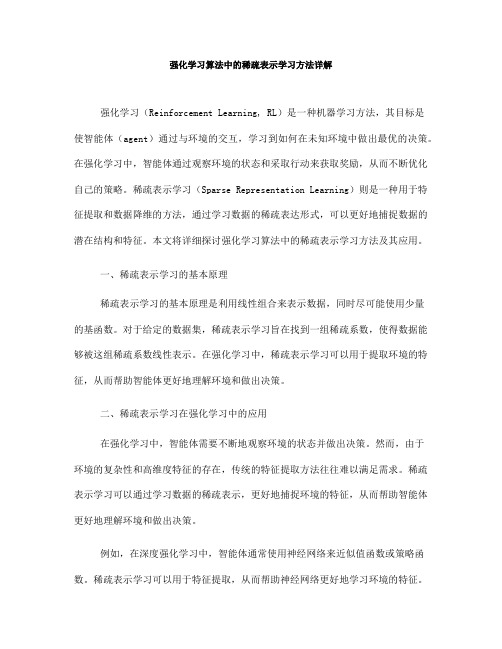
强化学习算法中的稀疏表示学习方法详解强化学习(Reinforcement Learning, RL)是一种机器学习方法,其目标是使智能体(agent)通过与环境的交互,学习到如何在未知环境中做出最优的决策。
在强化学习中,智能体通过观察环境的状态和采取行动来获取奖励,从而不断优化自己的策略。
稀疏表示学习(Sparse Representation Learning)则是一种用于特征提取和数据降维的方法,通过学习数据的稀疏表达形式,可以更好地捕捉数据的潜在结构和特征。
本文将详细探讨强化学习算法中的稀疏表示学习方法及其应用。
一、稀疏表示学习的基本原理稀疏表示学习的基本原理是利用线性组合来表示数据,同时尽可能使用少量的基函数。
对于给定的数据集,稀疏表示学习旨在找到一组稀疏系数,使得数据能够被这组稀疏系数线性表示。
在强化学习中,稀疏表示学习可以用于提取环境的特征,从而帮助智能体更好地理解环境和做出决策。
二、稀疏表示学习在强化学习中的应用在强化学习中,智能体需要不断地观察环境的状态并做出决策。
然而,由于环境的复杂性和高维度特征的存在,传统的特征提取方法往往难以满足需求。
稀疏表示学习可以通过学习数据的稀疏表示,更好地捕捉环境的特征,从而帮助智能体更好地理解环境和做出决策。
例如,在深度强化学习中,智能体通常使用神经网络来近似值函数或策略函数。
稀疏表示学习可以用于特征提取,从而帮助神经网络更好地学习环境的特征。
通过学习数据的稀疏表示,可以更好地捕捉环境的潜在结构和特征,从而提高智能体的决策能力。
三、稀疏表示学习方法在强化学习中,常用的稀疏表示学习方法包括字典学习、压缩感知和稀疏自编码器等。
这些方法都可以用于学习数据的稀疏表示,从而帮助智能体更好地理解环境和做出决策。
1. 字典学习字典学习是一种常用的稀疏表示学习方法,其目标是学习一组基函数(字典),使得数据能够被这组基函数线性表示。
在强化学习中,可以使用字典学习来提取环境的特征,从而帮助智能体更好地理解环境和做出决策。
纹理物体缺陷的视觉检测算法研究--优秀毕业论文
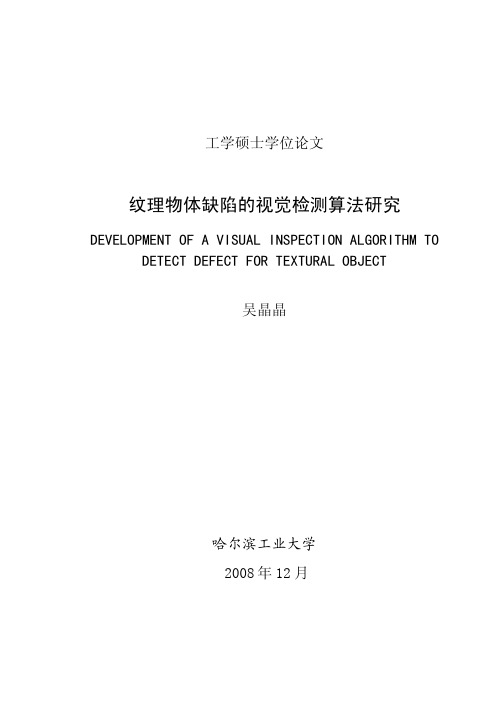
摘 要
在竞争激烈的工业自动化生产过程中,机器视觉对产品质量的把关起着举足 轻重的作用,机器视觉在缺陷检测技术方面的应用也逐渐普遍起来。与常规的检 测技术相比,自动化的视觉检测系统更加经济、快捷、高效与 安全。纹理物体在 工业生产中广泛存在,像用于半导体装配和封装底板和发光二极管,现代 化电子 系统中的印制电路板,以及纺织行业中的布匹和织物等都可认为是含有纹理特征 的物体。本论文主要致力于纹理物体的缺陷检测技术研究,为纹理物体的自动化 检测提供高效而可靠的检测算法。 纹理是描述图像内容的重要特征,纹理分析也已经被成功的应用与纹理分割 和纹理分类当中。本研究提出了一种基于纹理分析技术和参考比较方式的缺陷检 测算法。这种算法能容忍物体变形引起的图像配准误差,对纹理的影响也具有鲁 棒性。本算法旨在为检测出的缺陷区域提供丰富而重要的物理意义,如缺陷区域 的大小、形状、亮度对比度及空间分布等。同时,在参考图像可行的情况下,本 算法可用于同质纹理物体和非同质纹理物体的检测,对非纹理物体 的检测也可取 得不错的效果。 在整个检测过程中,我们采用了可调控金字塔的纹理分析和重构技术。与传 统的小波纹理分析技术不同,我们在小波域中加入处理物体变形和纹理影响的容 忍度控制算法,来实现容忍物体变形和对纹理影响鲁棒的目的。最后可调控金字 塔的重构保证了缺陷区域物理意义恢复的准确性。实验阶段,我们检测了一系列 具有实际应用价值的图像。实验结果表明 本文提出的纹理物体缺陷检测算法具有 高效性和易于实现性。 关键字: 缺陷检测;纹理;物体变形;可调控金字塔;重构
Keywords: defect detection, texture, object distortion, steerable pyramid, reconstruction
II
深度学习技术中的稀疏自编码器方法详解

深度学习技术中的稀疏自编码器方法详解深度学习在图像识别、语音识别、自然语言处理等领域取得了很大的成功,其中稀疏自编码器方法被广泛应用。
稀疏自编码器是一种无监督学习方法,能够自动从输入数据中学习到有效的表示,并在特征空间中进行重建。
稀疏自编码器是一种具有稀疏性约束的自编码器。
自编码器是一种神经网络模型,由输入层、隐藏层和输出层组成,其中隐藏层的维度一般比输入层低。
自编码器的目标是尽可能地重构输入数据,同时通过压缩隐藏层的维度来学习数据的有效表示。
稀疏性约束是稀疏自编码器的核心特性之一。
稀疏性要求隐藏层的激活值(或称为输出值)中只有少数几个元素是非零的,大部分元素都应该接近于零。
这样的约束能够促使自编码器学习到对输入数据进行压缩编码的稀疏表示。
稀疏性约束可以通过引入稀疏惩罚项来实现。
最常用的稀疏惩罚项是L1正则化,它可以通过限制隐藏层激活值的绝对值之和来实现。
具体地,对于每个隐藏层的激活值a,L1正则化可以定义为λ * |a|,其中λ是一个控制稀疏程度的超参数。
稀疏自编码器的训练过程包括两个阶段:编码阶段和解码阶段。
在编码阶段,输入数据通过前向传播传递到隐藏层,隐藏层的激活值被计算出来。
在解码阶段,隐藏层的激活值通过反向传播传递到输出层,重构数据被生成出来。
训练过程的目标是最小化重构误差,即输入数据与重构数据之间的差距。
稀疏自编码器的训练可以使用梯度下降法等优化算法进行。
在训练过程中,除了最小化重构误差外,还需要考虑稀疏性约束的损失。
稀疏自编码器中隐藏层的激活值可以使用sigmoid函数或ReLU函数进行非线性变换。
这些函数的选择对模型的性能和稀疏性有一定的影响。
稀疏自编码器方法在深度学习中有很多的应用。
其中一个重要的应用是特征学习。
通过训练稀疏自编码器,可以学习到输入数据的有效表示,这些表示可以作为其他任务(如分类、聚类等)的特征输入。
稀疏自编码器还可以被用作降维方法,通过减少输入数据的维度,可以减少计算复杂性,并提高模型的泛化能力。
关于自伴算子的奇异连续谱(英文)

关于自伴算子的奇异连续谱(英文)
张显文;ZHANG;Xian-wen
【期刊名称】《应用数学》
【年(卷),期】2005(18)2
【摘要】本文建立了自伴算子奇异连续谱的三个定理,它们推广了Barry Simon近期所获得的一些重要结果.
【总页数】6页(P188-193)
【关键词】奇异连续谱;正则空间;Baire典型集
【作者】张显文;ZHANG;Xian-wen
【作者单位】华中科技大学数学系,武汉,430074
【正文语种】中文
【中图分类】O175
【相关文献】
1.一类Schr dinger算子的连续谱测度(英文) [J], Shang Pengjian (Dept. of Appl. Math., Northern Jiaotong University, Beijing 100044)
2.广义Morrey空间中奇异积分算子和极大算子的加权不等式(英文) [J], 刘岚
3.一类不连续奇异Strum-Liouville算子的渐近估计(英文) [J], 周立广;王万义;索建青
4.带变量Calderón-Zygmund核的奇异积分算子在加权Morrey空间上的有界性(英文) [J], 潘亚丽;李昌文;温宗良
5.奇异2n阶J-自伴向量微分算子的预解算子 [J], 刘肖云;王忠
因版权原因,仅展示原文概要,查看原文内容请购买。
压缩映射原理
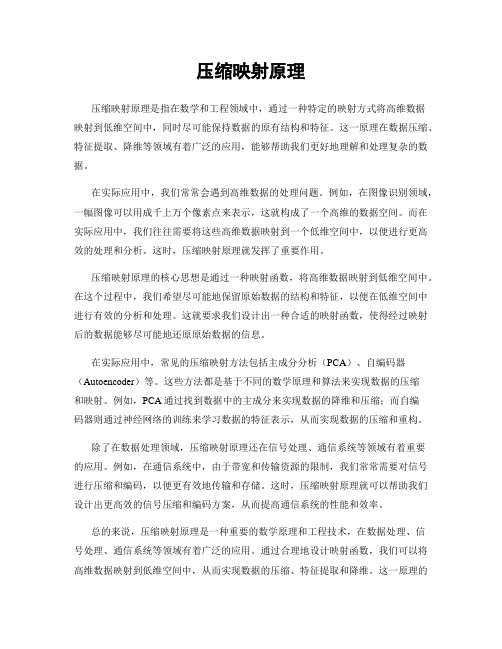
压缩映射原理压缩映射原理是指在数学和工程领域中,通过一种特定的映射方式将高维数据映射到低维空间中,同时尽可能保持数据的原有结构和特征。
这一原理在数据压缩、特征提取、降维等领域有着广泛的应用,能够帮助我们更好地理解和处理复杂的数据。
在实际应用中,我们常常会遇到高维数据的处理问题。
例如,在图像识别领域,一幅图像可以用成千上万个像素点来表示,这就构成了一个高维的数据空间。
而在实际应用中,我们往往需要将这些高维数据映射到一个低维空间中,以便进行更高效的处理和分析。
这时,压缩映射原理就发挥了重要作用。
压缩映射原理的核心思想是通过一种映射函数,将高维数据映射到低维空间中。
在这个过程中,我们希望尽可能地保留原始数据的结构和特征,以便在低维空间中进行有效的分析和处理。
这就要求我们设计出一种合适的映射函数,使得经过映射后的数据能够尽可能地还原原始数据的信息。
在实际应用中,常见的压缩映射方法包括主成分分析(PCA)、自编码器(Autoencoder)等。
这些方法都是基于不同的数学原理和算法来实现数据的压缩和映射。
例如,PCA通过找到数据中的主成分来实现数据的降维和压缩;而自编码器则通过神经网络的训练来学习数据的特征表示,从而实现数据的压缩和重构。
除了在数据处理领域,压缩映射原理还在信号处理、通信系统等领域有着重要的应用。
例如,在通信系统中,由于带宽和传输资源的限制,我们常常需要对信号进行压缩和编码,以便更有效地传输和存储。
这时,压缩映射原理就可以帮助我们设计出更高效的信号压缩和编码方案,从而提高通信系统的性能和效率。
总的来说,压缩映射原理是一种重要的数学原理和工程技术,在数据处理、信号处理、通信系统等领域有着广泛的应用。
通过合理地设计映射函数,我们可以将高维数据映射到低维空间中,从而实现数据的压缩、特征提取和降维。
这一原理的应用不仅能够帮助我们更好地理解和处理复杂的数据,还能够提高系统的性能和效率,具有重要的理论和实际意义。
随机自相似集的量子化维数
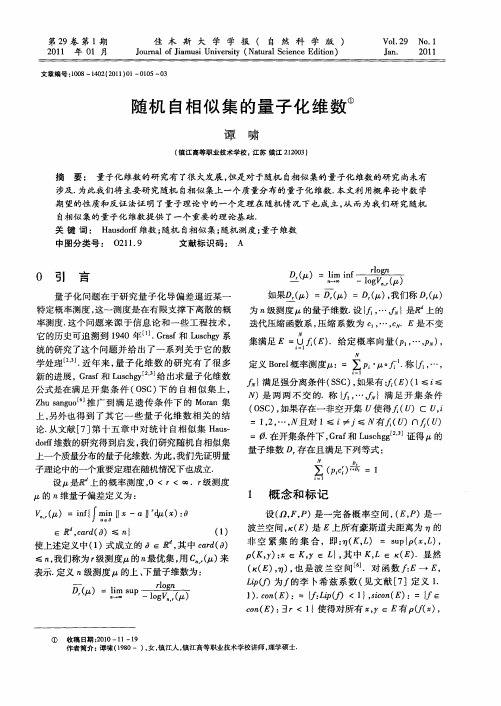
中图分 类号 : 0 1 。 2 19
文 献标 识码 : A
0 引 言
量子 化 问题 在 于 研 究 量 子 化 导偏 差 逼 近 某一 特定概 率测 度 , 一 测度 是在 有 限支 撑下 离散 的概 这
~
i i a ( : lr n )
n— ∞ 一 ■
一
I(J r
涉及. 为此我们将主要研 究随机 自 相似集上一个质量分布的量子化维数. 本文利用概率论 中 学 数 期望 的性 质和反 证 法证 明 了量 子理 论 中的 一个 定理 在 随机 情 况 下 也 成 立 , 而 为我 们研 究 随机 从
自相似 集 的量子 化 维数提 供 了一 个重要 的理 论基础 . 关 键 词 : Ha sof 维数 ; ud r f 随机 自相似 集 ; 随机 测度 ; 量子 维数
Ⅳ D
.
量子维数 D 存在且满足下列等式 : ,
∑ (c 蔫 =1 p )
1 概 念 和标 记
设 ( , J)是一 完 备 概 率 空 问 , , F, P ( P)是 一
的 n维量 子偏 差定 义 为 :
。
,
()=i { m n Ji f
一 I () l :
使 上述定 义 中 ( )式 成立 的 ∈ , 中 cr( 1 其 ad )
Hale Waihona Puke ≤r 我们称为 r t , 级测度 的n 最优集 , c ) 用 ( 来 表示. 定义 级测度 的上、 下量子维数为 :
i sp ) = lm u
日— … ∞ 一 1U y 一 .1“ ,
.
=
dr 维数的研究得到启发 , o f 我们研究随机 自 相似集
《基于四元数的边缘自适应正则化模型》范文
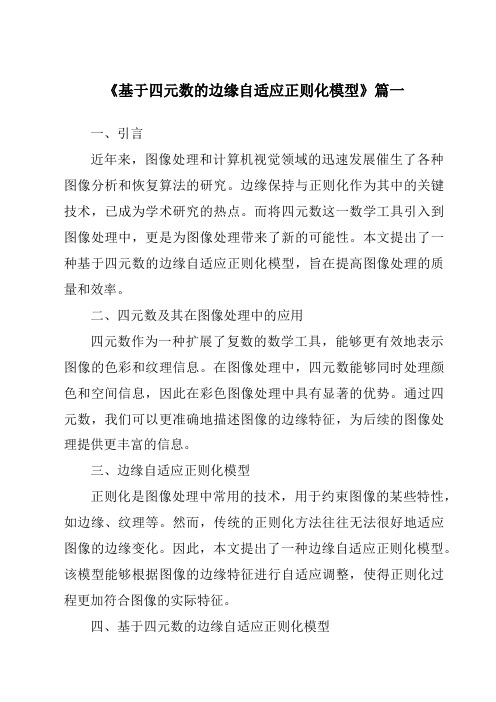
《基于四元数的边缘自适应正则化模型》篇一一、引言近年来,图像处理和计算机视觉领域的迅速发展催生了各种图像分析和恢复算法的研究。
边缘保持与正则化作为其中的关键技术,已成为学术研究的热点。
而将四元数这一数学工具引入到图像处理中,更是为图像处理带来了新的可能性。
本文提出了一种基于四元数的边缘自适应正则化模型,旨在提高图像处理的质量和效率。
二、四元数及其在图像处理中的应用四元数作为一种扩展了复数的数学工具,能够更有效地表示图像的色彩和纹理信息。
在图像处理中,四元数能够同时处理颜色和空间信息,因此在彩色图像处理中具有显著的优势。
通过四元数,我们可以更准确地描述图像的边缘特征,为后续的图像处理提供更丰富的信息。
三、边缘自适应正则化模型正则化是图像处理中常用的技术,用于约束图像的某些特性,如边缘、纹理等。
然而,传统的正则化方法往往无法很好地适应图像的边缘变化。
因此,本文提出了一种边缘自适应正则化模型。
该模型能够根据图像的边缘特征进行自适应调整,使得正则化过程更加符合图像的实际特征。
四、基于四元数的边缘自适应正则化模型本模型基于四元数进行构建,利用四元数描述图像的颜色和空间信息。
同时,模型引入了边缘自适应的机制,能够根据图像的边缘特征进行自适应调整。
具体来说,该模型通过计算四元数图像的梯度信息,提取出边缘特征,然后根据这些特征对正则化参数进行自适应调整。
这样,模型在处理不同边缘特征的图像时,都能保持较高的处理质量和效率。
五、实验结果与分析为了验证本文提出的模型的性能,我们进行了大量的实验。
实验结果表明,基于四元数的边缘自适应正则化模型在处理彩色图像时具有显著的优势。
与传统的正则化方法相比,该模型能够更好地保持图像的边缘特征,同时提高了图像的处理质量和效率。
此外,该模型还具有较强的鲁棒性,能够适应不同类型和不同质量的图像。
六、结论本文提出了一种基于四元数的边缘自适应正则化模型,旨在提高图像处理的质量和效率。
通过引入四元数和边缘自适应的机制,该模型能够更准确地描述图像的边缘特征,并对其进行有效的处理。
支持向量机模型在垃圾邮件过滤中的应用
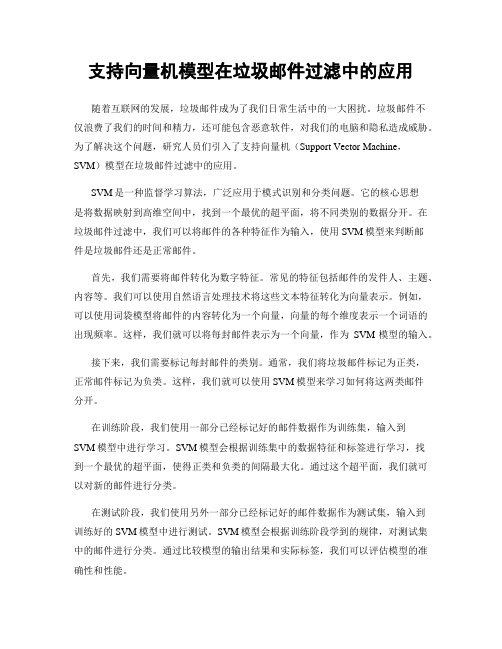
支持向量机模型在垃圾邮件过滤中的应用随着互联网的发展,垃圾邮件成为了我们日常生活中的一大困扰。
垃圾邮件不仅浪费了我们的时间和精力,还可能包含恶意软件,对我们的电脑和隐私造成威胁。
为了解决这个问题,研究人员们引入了支持向量机(Support Vector Machine,SVM)模型在垃圾邮件过滤中的应用。
SVM是一种监督学习算法,广泛应用于模式识别和分类问题。
它的核心思想是将数据映射到高维空间中,找到一个最优的超平面,将不同类别的数据分开。
在垃圾邮件过滤中,我们可以将邮件的各种特征作为输入,使用SVM模型来判断邮件是垃圾邮件还是正常邮件。
首先,我们需要将邮件转化为数字特征。
常见的特征包括邮件的发件人、主题、内容等。
我们可以使用自然语言处理技术将这些文本特征转化为向量表示。
例如,可以使用词袋模型将邮件的内容转化为一个向量,向量的每个维度表示一个词语的出现频率。
这样,我们就可以将每封邮件表示为一个向量,作为SVM模型的输入。
接下来,我们需要标记每封邮件的类别。
通常,我们将垃圾邮件标记为正类,正常邮件标记为负类。
这样,我们就可以使用SVM模型来学习如何将这两类邮件分开。
在训练阶段,我们使用一部分已经标记好的邮件数据作为训练集,输入到SVM模型中进行学习。
SVM模型会根据训练集中的数据特征和标签进行学习,找到一个最优的超平面,使得正类和负类的间隔最大化。
通过这个超平面,我们就可以对新的邮件进行分类。
在测试阶段,我们使用另外一部分已经标记好的邮件数据作为测试集,输入到训练好的SVM模型中进行测试。
SVM模型会根据训练阶段学到的规律,对测试集中的邮件进行分类。
通过比较模型的输出结果和实际标签,我们可以评估模型的准确性和性能。
SVM模型在垃圾邮件过滤中的应用有许多优势。
首先,SVM模型可以处理高维数据,适用于处理大量的特征。
这对于垃圾邮件过滤来说非常重要,因为邮件的特征可能非常多。
其次,SVM模型可以处理非线性问题,通过使用核函数将数据映射到高维空间中,找到一个非线性的超平面来分割数据。
基于可分离字典的稀疏和低秩表示图像去噪
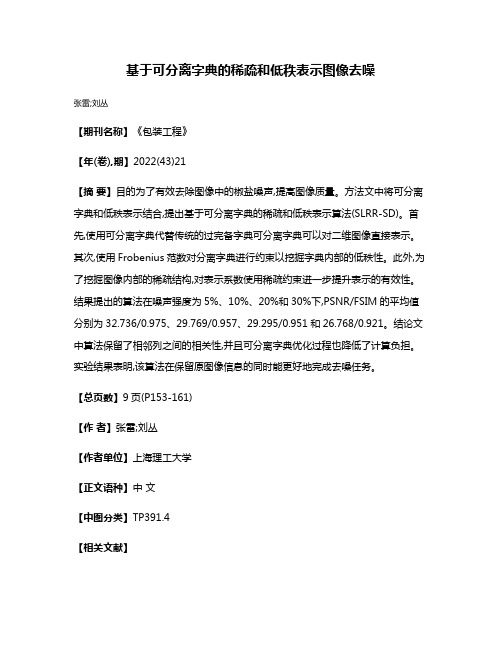
基于可分离字典的稀疏和低秩表示图像去噪
张雷;刘丛
【期刊名称】《包装工程》
【年(卷),期】2022(43)21
【摘要】目的为了有效去除图像中的椒盐噪声,提高图像质量。
方法文中将可分离字典和低秩表示结合,提出基于可分离字典的稀疏和低秩表示算法(SLRR-SD)。
首先,使用可分离字典代替传统的过完备字典可分离字典可以对二维图像直接表示。
其次,使用Frobenius范数对分离字典进行约束以挖掘字典内部的低秩性。
此外,为了挖掘图像内部的稀疏结构,对表示系数使用稀疏约束进一步提升表示的有效性。
结果提出的算法在噪声强度为5%、10%、20%和30%下,PSNR/FSIM的平均值分别为32.736/0.975、29.769/0.957、29.295/0.951和26.768/0.921。
结论文中算法保留了相邻列之间的相关性,并且可分离字典优化过程也降低了计算负担。
实验结果表明,该算法在保留原图像信息的同时能更好地完成去噪任务。
【总页数】9页(P153-161)
【作者】张雷;刘丛
【作者单位】上海理工大学
【正文语种】中文
【中图分类】TP391.4
【相关文献】
1.基于低秩非局部稀疏表示的图像去噪模型
2.基于稀疏表示与字典学习的彩色图像去噪算法
3.基于带权稀疏表示和字典学习的图像去噪模型
4.基于非抽样小波字典和稀疏表示的图像去噪方法
5.基于判别式低秩字典学习的人脸识别稀疏表示
因版权原因,仅展示原文概要,查看原文内容请购买。
自编码和超混沌映射相结合的图像加密算法
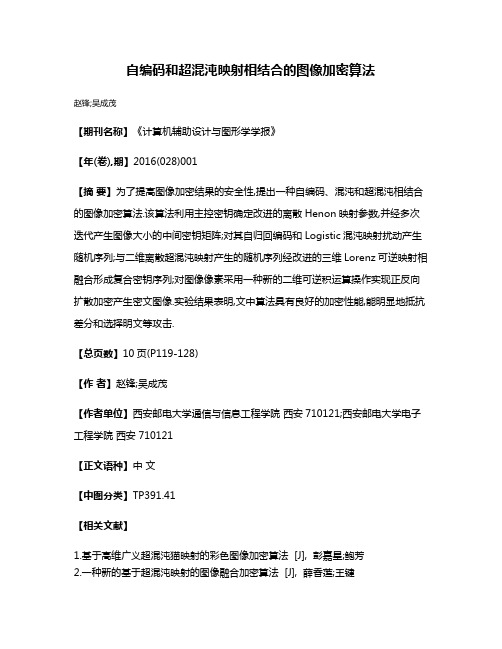
自编码和超混沌映射相结合的图像加密算法
赵锋;吴成茂
【期刊名称】《计算机辅助设计与图形学学报》
【年(卷),期】2016(028)001
【摘要】为了提高图像加密结果的安全性,提出一种自编码、混沌和超混沌相结合的图像加密算法.该算法利用主控密钥确定改进的离散Henon映射参数,并经多次迭代产生图像大小的中间密钥矩阵;对其自归回编码和Logistic混沌映射扰动产生随机序列;与二维离散超混沌映射产生的随机序列经改进的三维Lorenz可逆映射相融合形成复合密钥序列;对图像像素采用一种新的二维可逆积运算操作实现正反向扩散加密产生密文图像.实验结果表明,文中算法具有良好的加密性能,能明显地抵抗差分和选择明文等攻击.
【总页数】10页(P119-128)
【作者】赵锋;吴成茂
【作者单位】西安邮电大学通信与信息工程学院西安710121;西安邮电大学电子工程学院西安 710121
【正文语种】中文
【中图分类】TP391.41
【相关文献】
1.基于高维广义超混沌猫映射的彩色图像加密算法 [J], 彭嘉星;鲍芳
2.一种新的基于超混沌映射的图像融合加密算法 [J], 薛香莲;王键
3.基于超混沌映射的医学图像小波域加密算法 [J], 梁涤青;陈志刚;邓小鸿
4.基于超混沌映射的位平面彩色图像加密算法 [J], 黎桠娟; 叶瑞松
5.基于量子混沌映射和Chen超混沌映射的图像加密算法 [J], 张晓宇;张健
因版权原因,仅展示原文概要,查看原文内容请购买。
基于向量模的坐标变换不变性的碎片匹配方法
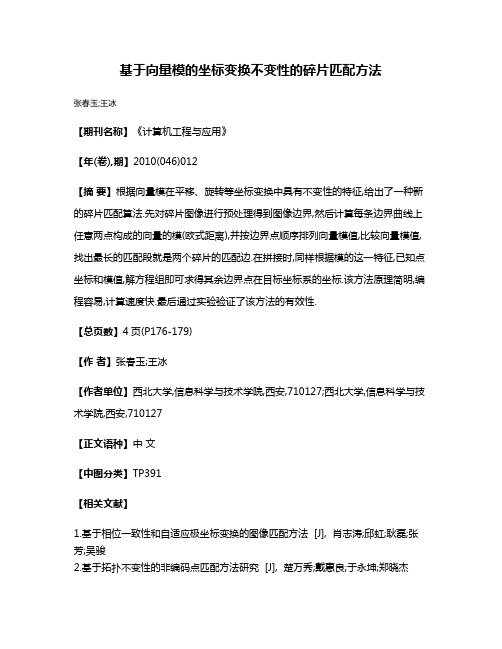
基于向量模的坐标变换不变性的碎片匹配方法
张春玉;王冰
【期刊名称】《计算机工程与应用》
【年(卷),期】2010(046)012
【摘要】根据向量模在平移、旋转等坐标变换中具有不变性的特征,给出了一种新的碎片匹配算法.先对碎片图像进行预处理得到图像边界,然后计算每条边界曲线上任意两点构成的向量的模(欧式距离),并按边界点顺序排列向量模值,比较向量模值,找出最长的匹配段就是两个碎片的匹配边.在拼接时,同样根据模的这一特征,已知点坐标和模值,解方程组即可求得其余边界点在目标坐标系的坐标.该方法原理简明,编程容易,计算速度快.最后通过实验验证了该方法的有效性.
【总页数】4页(P176-179)
【作者】张春玉;王冰
【作者单位】西北大学,信息科学与技术学院,西安,710127;西北大学,信息科学与技术学院,西安,710127
【正文语种】中文
【中图分类】TP391
【相关文献】
1.基于相位一致性和自适应极坐标变换的图像匹配方法 [J], 肖志涛;邱虹;耿磊;张芳;吴骏
2.基于拓扑不变性的非编码点匹配方法研究 [J], 楚万秀;戴惠良;于永坤;郑晓杰
3.基于点集不变性匹配的目标检测与识别方法 [J], 田原;梁德群;吴更石
4.基于群体智能的三维碎片全局最优匹配方法 [J], 孙家泽;耿国华
5.基于形状骨架图匹配的文物碎片自动重组方法 [J], 张雨禾;耿国华;魏潇然;张靖;周明全
因版权原因,仅展示原文概要,查看原文内容请购买。
- 1、下载文档前请自行甄别文档内容的完整性,平台不提供额外的编辑、内容补充、找答案等附加服务。
- 2、"仅部分预览"的文档,不可在线预览部分如存在完整性等问题,可反馈申请退款(可完整预览的文档不适用该条件!)。
- 3、如文档侵犯您的权益,请联系客服反馈,我们会尽快为您处理(人工客服工作时间:9:00-18:30)。
a r X i v :0808.3174v 1 [h e p -p h ] 23 A u g 2008Preprint typeset in JHEP style -HYPER VERSIONPeter Christian Bruns Universit¨a t Bonn,Helmholtz–Institut f¨u r Strahlen–und Kernphysik (Theorie),D-53115Bonn,Germany E-mail:bruns@itkp.uni-bonn.de Ulf-G.Meißner Universit¨a t Bonn,Helmholtz–Institut f¨u r Strahlen–und Kernphysik (Theorie)and Bethe Center for Theoretical Physics,D-53115Bonn,Germany and Forschungszentrum J¨u lich,Institut f¨u r Kernphysik (Theorie)and J¨u lich Center for Hadron Physics,D-52425J¨u lich,Germany E-mail:meissner@itkp.uni-bonn.de Abstract:We extend the method of infrared regularization to spin-1fields coupled to baryons.As an application,we discuss the axial form factor of the nucleon.Keywords:Chiral Lagrangians,QCD,vector mesons.1.IntroductionIn a recent work[1],the scheme of infrared regularization(developed in its original form by Becher and Leutwyler[2])was extended to the case of explicit meson resonances interacting with soft pions,as e.g.thefirst step towards a systematic inclusion of vector mesons in the meson sector of Chiral Perturbation Theory(ChPT).It is the aim of this article to provide a further extension of infrared regularization to the situation where baryons as well as vector mesons are present.This can be considered as a synthesis of the results in[1] and[2].Such an extension is not only of interest in itself,but can be applied to a plethora of observables,where vector and axial-vector mesons are known to play an important role, such as the electroweak form factors of the nucleon.As one example we mention the contribution of theπρloop to the strangeness form factors of the nucleon[3,4].Infrared regularization(IR)is a solution to the following problem.The presence of mass scales which must be considered as’heavy’compared to the masses and momenta of the soft pions will in general mess up the usual power counting rules of ChPT by which the perturbation series of the effective theory is ordered[5–7].This observation wasfirst made when baryons were incorporated in the framework of ChPT[8](for a recent review on baryon ChPT we refer to[9]).The procedure of infrared regularization separates the (dimensionally regularized)one-loop graphs of baryon ChPT into a part which stems from the soft pion contribution and a part generated from loop momenta close to the’heavy’scale.The latter portion of the loop graph,called the’regular’part,will usually not be in accord with the low-energy power counting,but can always be absorbed in local terms derived from the effective Lagrangian.It is therefore dropped from the loop graph,and only thefirst part,called the infrared singular part of the loop integral,is kept.Though both the vector mesons and the baryons interact as’heavy’particles with the pions,the power counting is different for the two species,at least for the kinds of Feynman graphs we consider in this work.There,the vector mesons appear only as internal lines with small momenta far from their mass shell,so that the resonance propagator is counted as O(q0) (where q indicates some small momentum scale or Goldstone boson mass),while the baryon propagator is counted as O(q−1),since the baryon is pushed from its mass shell only by a small amount due to its interaction with the soft pions and vector mesons.In the graphs we treat here,only one single baryon is present,with the baryon line running through the diagram undergoing only soft interactions.The number of the virtual vector mesons, however,is notfixed.The pion propagator is counted as O(q−2),as usual,both the pion momentum and the pion mass being of O(q).Appropriate powers of q are also assigned to vertices from the effective Lagrangian.Finally,the measure of every d-dimensional loop integration is booked as O(q d).This counting scheme applies,of course,to tree graphs, but also to the infrared singular,or soft,parts of the loop graphs.The regular parts of the loop graphs are not guaranteed to obey the power counting rules.These general remarks will be exemplified in the following sections.Before working out the case where both baryons and vector mesons appear in a Feyn-man diagram,we will briefly review the scheme of infrared regularization for loop integrals where only one heavy scale shows up.This will not only serve to give a unified presenta-tion of the method,but also provide some results needed for an application of the general scheme to the axial form factor of the nucleon.Before starting with the presentation of the formalism,let us mention that the loop integrals studied in this work have also been treated,using a different regularization scheme which is in some respect complementary to the one used here,in Ref.[10].2.IR regularization in the pion-nucleon systemWhen only pions and nucleons are treated as explicitfields of the effective theory,the fundamental loop integral one has to consider isI MB(p2)= d d l((p−l)2−m2)(l2−M2).(2.1)Here,M is the pion mass(being of chiral order O(q))and m is the nucleon mass.Applying the low-energy power counting scheme outlined in the introduction,one would assign a chiral order of q d−3to this integral.We will see in a moment that only an appropriately extracted low-energy part of I MB will obey this power counting requirement.All the other pion-nucleon loop integrals are either only trivially modified by the in-frared regularization scheme,or they can be derived from eq.(2.1)(see sec.6of[2]).For example,the scalar tadpole integral containing only the pion propagator is not modifiedat all,as there is no’hard momentum’structure present that could lead to a nonvanishing regular part of this integral.Thus we haveI IR M=I M= d d l l2−M2,and a direct calculation givesI IR M=Γ(1−d (4π)d(2π)di(2π)d 10dz2) 2 10dz2,(2.4)where we have definedα=M2/m2(note the difference to ref.[2],where this letter is reserved forαBL=M/m).Fractional powers of the small variableαwill be produced near z=0:there,the integrand is approximately(α)dnear z =1.The extraction of the part of the integral proportional to d -dependent powers of αnow proceeds as follows:the parameter integration is split into two parts like 10= ∞0− ∞1.(2.5)We will first show that the second integral on the r.h.s.is regular,i.e.expandable,in the variable α.This is easy to see,because for z ≥1,the integrand can be expanded like(z 2−αz +α)d 2+k )2)αk z 2 k .(2.6)Interchanging integration and summation (which is a valid operation at least for some range of d ),one gets for the regular partR ≡m d −4Γ(2−d(4π)d (z 2−αz +α)2−d 2)2+O (α).(2.7)At this point we should make the remark that the extension of the parameter integration to infinity will lead to divergences as d increases.The infrared singular or regular parts are then defined as follows:The parameter integrals are computed for the range of d where they are well-defined,and the result will be continued analytically to arbitrary values of d .This amounts to the suppression of power divergences of the parameter integrals,which have nothing to do with the infrared singularity at z =0,and will be cancelled anyway on the r.h.s.of eq.(2.5).Next we must show that the first term on the r.h.s.of eq.(2.5)is proportional to a d -dependent power of α.To see this,we substitute z =√(z 2−αz +α)2−d αd −3 ∞0dy αy +1)2−dαsimilar to eq.(2.6).Thus we have found that theparameter integral from zero to infinity is proportional to a d -dependent power of α.Theinfrared singular part I IR MBof the loop integral therefore equals I IR MB =−m d −4Γ(2−d(4π)d (z 2−αz +α)2−d αd −32∞ k =0√k !Γ k +12 .(2.8)As d →4,this has the well-known leading termI IR MB (d →4)=1m +...,where the dots indicate terms of higher order in M/m .This is clearly in accord with the low-energy power counting.In contrast to that,the first term of the expansion of the reg-ular part R obviously violates this counting when d →4.The infrared regularization nowprescribes to drop R from the loop contribution and substitute I IR MB for I MB.Moreover, the poles of I IR MB in d−4are also absorbed in a renormalization of the masses and coupling constants of the effective Lagrangian.Again,for a more general and comprehensive treat-ment of the IR scheme in the pion-nucleon system,the reader should consult the original article of Becher and Leutwyler[2].3.IR regularization for vector mesons and pionsIn this section,we consider another case of infrared regularization,first examined in[1]. The internal baryon lines from the preceding section are now replaced by vector meson lines, however,the vector mesons do not show up as external particles in the graphs we consider here(an example for the treatment of such a graph can be found in sec.11of[1]).The only external particles here are pions(or,in some cases,soft photons etc.),so that there are only small external momenta of order O(q)flowing into the loop.The fundamental scalar loop integral is in this caseI MV(q2)= d d l((q−l)2−M2V)(l2−M2),(3.1)where M V is the mass of the heavy meson resonance and q is some small external momentum (small with respect to the resonance mass M V).This is,in principle,the same function as in eq.(2.1),so the reader might ask why we devote this section to the examination of this case.The point is that the extraction of the infrared singular part of I MV must proceed along different lines here.As shown in[1],a splitting like that of eq.(2.5)does not amount to a separation into infrared singular and regular parts as in the preceding section.This can be traced back to the fact that the extension of the parameter integrals to infinity leads to a singular behaviour of the loop function near q2=0.Of course,also I IR MB has such a singularity as the external momentum squared goes to zero(see sec.5.4of[2]),but the point p2=0lies far outside the low-energy region in that case.Here,however,the point q2=0lies at the center of the low-energy region,so the infrared singular and regular parts can not be expressed as parameter integrals from zero or one to infinity,respectively.For example,a’regular’part defined as being proportional to the parameter integral from one to infinity would not be expandable around q2=0,as it should be in order to be able to absorb the corresponding terms in a renormalization of the local operators in the effective Lagrangian.To circumvent this difficulty,we will take up the following simple idea from[1].We observe that I MV is analytic at q2=0,the only singularity being the threshold branch point at q2=(M V+M)2,which is far outside the range of small q2-values.Expanding I MV in q2,the analyticity properties in that variable are obvious.Each coefficient in this expansion can be split into an infrared singular and a regular part almost like in eq.(2.5). Extracting the infrared singular part proportional to d-dependent powers of the pion mass of each coefficient,and resumming the series,one arrives at a well-defined expression for the infrared singular part of the loop integral I MV that is(by construction)expandable in the small variable q2/M2V.To start with the analysis,let us first consider the special case where the external momentum vanishes:q =0.Then we haveI MV (0)= d d l (l 2−M 2V)(l 2−M 2)=1(2π)d i (2π)diM 2−M 2V d d l l 2−M 2.(3.2)It should be clear that there will only be corrections of O (q 2)to this result when we compute the regularized integral for nonvanishing q .We introduce the following variables,˜α=M 2M 2V ,(3.3)which we assume to be small in the sense that ˜α,˜β≪1.Just like in sec.2,we use the Feynman parameter trick to writeI MV (q 2)=−M d −4V Γ(2−d (4π)d (˜βz 2+z (1−˜α−˜β)+˜α)2−d 2)2 10dz 2 1+˜βz 22−2.This can be expanded according toI MV (q 2)=−M d −4V2∞ k =0Γ(d k !Γ(d 2)dz2 ˜βz2(z (1−˜α−˜β)+˜α)2+k −d 2−1+k y 2k 2.(3.5)Divergences of the parameter integral due to the extension of the upper limit to infinity are again handled by analytic continuation in d.It can be expressed in terms of Gamma functions:∞0dy y2k2=Γ(2k+1)Γ(1−d(1−˜α−˜β)2k+1Γ(2−d2−1) 2−1−k)=(−1)kΓ(2−dΓ(2−d(4π)d 2−1∞ k=0(−˜α˜β)k2−k) (2π)di(q2+l2−M2V)k+1→ d d l l2−M2∞ k=0(2q·l)k(2π)di(2q·l)kWhile thefirst step is just the expansion of the vector meson propagator pole imposed by the prescription,the second step deserves a comment:There,we have used the same trick of partial fractions to split offsome hard momentum contributions as in the treatment of I MV(0),but now this was performed k+1times.In the last step,summation and integration were ing the formulad d l l2−M2=(−q2M2)n M d−2Γ(n+1Γ(12−n)2(3.8)and the fact that the loop integrals in the series vanish if k is odd,the result of the transformation isI soft MV (q2)=M d−22∞ n=0(−4q2M2)n2)Γ(1−dΓ(1Γ(n+1)=4nΓ(n+1Γ(1Using these kinematic relations,we can rewrite the fundamental scalar loop integral I MBV (k 2)≡ d d l ((p −l )2−m 2)((k +l )2−M 2V )(l 2−M 2)(4.2)with the help of the usual Feynman parameter trick,asd d l(y ((p −l )2−m 2)+x ((k +l )2−M 2V)+(1−x −y )(l 2−M 2))3.(4.3)Doing the loop integration in the usual manner,we getI MBV (k 2)=m d −6Γ(3−d(4π)d (y 2−αy +α+β(x 2+xy )+x (γ−α−β))3−dm 2≪1,β=k 2m 2∼O (1).were used.In particular,we have assumed here that the nucleon and the meson resonance are roughly of the same order of magnitude (in the real world,we have γ∼2/3for the rho resonance,which is good enough for our purposes).We should remark here that there is,of course,a second graph with the same topology,where the pion and the resonance line are interchanged (see fig.2).The expression for thecorresponding scalar loop integral is˜I MBV (k 2)≡ d d l ((¯p −l )2−m 2)((l −k )2−M 2V)(l 2−M 2).(4.5)However,the reader can convince himself that,due to the on-shell kinematics specified in eq.(4.1),this will give exactly the same expression as in eq.(4.4).Thus,we can focus on the integral I MBV .In analogy to sec.3,it will be instructive to begin with the special case where k =0.Since we must split offthe terms where only propagators of heavy particles occur,we can obviously apply the same partial fraction method that led to eq.(3.2).The remaining pion-nucleon integral can be dealt with as in sec.2.This givesI IR MBV (0)=I IR MB(m 2)2)2∞0 ∞0dxdy 2=m d −62)2 ∞0dy 2(compare the last line with the l.h.s of eq.(2.8)).Once again,the possible divergence for large d at x →∞was regularized by analytic continuation from small d as before.It is reassuring to see that eq.(4.6)is reproduced in this way.The extension of both parameterinte-Figure 1:Illustration of the integration rangesfor the infrared singular and the regular part ofI MBV .The shaded triangle is the region inte-grated over in eq.(4.4).The three rays indi-cate the extension of the connections from thesoft point at (0,0)to the hard line from (0,1)to(1,0).grations to infinity is the natural generaliza-tion of the prescription used in sec.2.This can be seen as follows.In eq.(4.3),we chose our Feynman parameters such that the pion propagator contributes with the weight one at x =y =0,while the vector meson and the nucleon propagator have their maximum weight at (x,y )=(1,0)and (0,1),respec-tively.Consequently,the infrared singular-ity is located in parameter space at the point (x,y )=(0,0).Indeed,a look at eq.(4.4)confirms that the integrand in that expres-sion is approximately αdrange be extended to infinity,in each coefficient of the expansion.We must expect that a similar phenomenon will occur in the present case.To exclude this from the start,we expand I MBV in analogy to eq.(3.7):I MBV (k 2)=m d −62∞ j =0Γ(d Γ(d 2)dxdy (βx (x +y ))j 2+j=m d −62∞ j =0Γ(d Γ(d 2)dxdy ( j l =0 j l βj x l +j y j −l )2+j .There is still some β-dependence in the denominator,but in that combination,it will turn out to be harmless.We extend the parameter integrations to Q +and defineI IR MBV (k 2)=m d −62∞ j =0Γ(d Γ(d 2)dxdy ( j l =0 j l βj x l +j y j −l )2+j .Since the denominator is always positive for 0<α≪1,|β|≪1,the x -integration can readily be done using the formula∞0dx x n b n +1Γ(n +1)Γ(D −(n +1))(4π)d 2−l )(γ−α−β)j +l +1×× ∞0y j −l dy 2−l .In the next step,we can write down the chiral expansion of the y -integral,using the same method as in sec.2.The generalized formula is∞0dy y n αn +1−2D ∞ k =0√k !Γ(n +k +12)(4π)d αd −3+j +l +k 2)Γ(3−d −l −j +k 2Γ(j −l +1)Γ(k +1)Γ(l +1).(4.9)The only expressions we have not expanded in the small variables are the factors of (γ−α−β)in the denominator,but this can of course be done:the corresponding geometric series is absolutely convergent due to the assumption that γ∼O (1).To complete the proof that eq.(4.9)is the correct infrared singular part of I MBV ,we have to show that all the terms we dropped in the extraction procedure described aboveare regular inα.Those terms are proportional to parameter integrals over the region R+, of the general typeR j= R+dxdy(x(x+y))j2+j= ∞z=1 z x=0dxdz(xz)j2+j.Here we have traded the variable y for z≡x+y.Onefinds that the function(z−x)2+x(γ−β)f(z,x)=001100110011001100110011N(p)N(p)P(l)A(k)N(p)N(p)p−l P(l)p−l A(k)V(l−k)V(l+k)Figure 2:Triangle graphs contributing to the axial form factor of the nucleon.The dashed line represents the pion,while the double line stands for the vector meson.The letter A indicates the external axial source,N denotes the nucleon under consideration.graphs of fig.(2),with one nucleon,one pion and one resonance line,in the framework of the extended infrared regularization scheme developed in the preceding sections.First,we must set up the necessary formalism and collect the various terms from the effective Lagrangian we need for the computation.By Lorentz invariance,the matrix element of the axial currentA i µ(x )≡¯q (x )γµγ5τi2m +G T (t )σµνk ν2u (p )e ikx .(5.1)In the above expressions,q is the quark field spinor,q T =(u,d ),N ′is the outgoing nucleon with momentum ¯p ,N labels the incoming nucleon with momentum p ,and k =¯p −p ,t ≡k 2.The symbols τi denote the usual Pauli matrices.Finally,¯u ′and u are the Dirac spinors associated with the outgoing and incoming nucleon,respectively.Assuming perfect isospin symmetry and charge conjugation invariance,as we will do here,leads to G T ≡0.The relation of G A and G P to the quantities F 1,2used in [13]is F 1(t )=G A (t ),2mF 2(t )=−G P (t ).For later reference,we give the representation of G A up to order q 3that can be found in [13]:G A (t )=g A +4¯d16M 2+d 22t −g 3A M 224πmF 2 3+3g 2A −4c 3m +8c 4m +O (q 4).(5.2)Here F and g A denote the pion decay constant and the nucleon axial charge in the chiral limit,respectively,while the coefficients c i ,d i are LECs showing up in the pion-nucleon effective Lagrangian at order two and three,respectively.For a precise definition of the underlying Lagrangian see ref.[17].We now turn back to the calculation of the axial form factor in the presence of vector mesons.We write down the relevant terms in the effective Lagrangian and give the neces-sary rules for the vertices and propagators required for the calculation.First,the lowest order chiral Lagrangian for the pion-nucleon interaction readsL(1)N=¯ψ(i/D−m)ψ+g A2F ,uµ=i{u†,∂µu}+u†rµu−ulµu†,rµ=vµ+aµ,lµ=vµ−aµ.In the last line,we have introduced external isovector vector and axial-vector sources,vµand aµ,vµ=v iµτi2.The covariant derivative Dµin eq.(5.3)is defined asDµ=∂µ+Γµ,Γµ=12u†rµu−i2F/qγ5τafor an outgoing pion of momentum q.Now we turn to the effective Lagrangians involving the vector mesonfields.We choose a representation in terms of an antisymmetric tensorfield Wµν[1,15,18].The corresponding free Lagrangian isL kin W=−14M2V WµνWµν ,whereWµν=12W iµντi= ρ02ρ+ρ−−ρ02µν.The brackets ... denote the trace in isospin space.From L kin W,one derives the tensorfield propagator in momentum space,T ijµν,ρσ(k)=iδijM2V−k2.At lowest chiral order,the interaction of the rho meson with the pions is given by[15]L int W=F V2 F+µνWµν +iG V2 [uµ,uν]Wµν .(5.4)In thefirst term we have used the definitionsF±µν=uF Lµνu†±u†F Rµνu,F Lµν=∂µlν−∂νlµ−i[lµ,lν],F Rµν=∂µrν−∂νrµ−i[rµ,rν].The external sources rµ,lµare counted as O(q),so that F±µνis of chiral order O(q2).Also, uµis of O(q).Therefore,L int W leads to vertices of chiral order O(q2).Using the method of external sources to derive Greens functions from the generating functional,we must extract the amplitudes linear in the source aµto compute the matrix element of eq.(5.1).For the triangle graphs considered here,we need the vertex that connects the vector meson and the pion with the external axial source.From eq.(5.4),wefind the corresponding vertex ruleǫiac G V2F(kµgντ−kνgµτ) .Here i,a,c are the isospin indices associated with the axial source aτ,the pion and the vector mesonfield Wµν,respectively,q is the four-momentum of the outgoing pion.Since k and q are counted as small momenta,the chiral order of this vertex rule is in accord with the power counting for the interaction Lagrangian.The restrictions of chiral symmetry are not that strong for the interaction of the vector mesons with the nucleons:Here,there are terms of chiral order O(q0).The leading terms of the interaction Lagrangian have been given in ref.[19].For the SU(2)case we consider here,the relevant terms areL NW=R V¯ψσµνWµνψ+S V¯ψγµDνWµνψ+T V¯ψγµDλWµνDλDνψ+U V¯ψσλνWµνDλDµψ.(5.5) In the notation of[19],we have R V=R D+R F,S V=S D+S F,etc.The definition of σµνis standard,σµν=i[γµ,γν]/2.It turns out that only the piece proportional to G V from eq.(5.4)and the piece proportional to R V from eq.(5.5)contribute at lowest order to the diagrams computed here,the chiral expansion of which starts at O(q3)(given that a scheme like infrared regularization is used that preserves the power counting rules).To keep the presentation short,we show only the contribution from those terms and therefore neglect some higher order contributions.However,this will be sufficient to compare our results to the representation up to O(q3)given by Schweizer[13].The evaluation of thefirst graph gives(seefig.(2))I1= d d l F(lµgντ−lνgµτ)ǫiac i2F/lγ5τa iTµν,ρσcd(l−k)√(2π)d R V2iσµντciTµν,ρσcd(l+k)2F/lγ5τa i F(lρgστ−lσgρτ)ǫida .We have left out the Dirac spinors ¯u ,u here.Since we consider on-shell nucleons,we can use the Dirac equation to simplify the numerators of the integrals,¯u (¯p )/¯p =¯u (¯p )m ,/p u (p )=mu (p ).We will make some remarks on the computation of I 1(the computation of I 2can be done analogously).In a first step,we reduce the full loop integral to a linear combination of scalar loop integrals,which have been treated in detail in the preceding sections.Scalar loop integrals without a pion propagator denominator are dropped using infrared regularization,since they are pure regular parts.Therefore we can replace l 2→M 2everywhere in the numerator.With the abbreviation g 1=2√M 2VF 2we getI 1=g 1τid d l 2(k τ−l τ)(/l /k −/k /l ))γ5(2π)d i ((M 2−k ·l )(l ρ−k ρ)σρτ+i((l −k )2−M 2V )(l 2−M 2)− d d l ((¯p −l )2−m 2)(l 2−M 2).For completeness,we shall give the relevant loop integrals with tensor structures in ing the coefficient functions defined there,the result for the first integral I 1can be written asI 1=−ig 1τi (γτI (γ)1+k τI (k )1+¯p τI (p )1)γ5,(5.6)where the coefficients readI (γ)1=2m (M 2V −k 2)C 1+mk 2(I A MBV +I B MBV )(M 2+M 2V −k 2)−mM 2(M 2+M 2V −k 2)I MBV +mM 2I MB ,I (k )1=2m 2(M 2V −k 2)(3C 2+C 3+4C 4)+4m 2M 2(I A MBV +I B MBV )−2m 2(M 2V −k 2)(3I A MBV +I B MBV )+2m 2(I A MBV −I B MBV )(M 2+M 2V −k 2)−4m 2M 2I MBV +t (1)MV +(M 2V−2k 2)I (1)MV +(k 2−M 2V )I MV +(M 2+M 2V −k 2)(I MV −I (1)MV ),I (p )1=2m 2(M 2V −k 2)(3C 2−C 3−2C 4)+4m 2M 2(I A MBV −I B MBV)−2m 2(I A MBV −I B MBV )(M 2+M 2V −k 2)+2t (0)MV −2m 2I (1)MB +(M 2+M 2V −k 2)(I (1)MV −I MV )−I M .What concerns the evaluation of I 2,we note that it is given byI 2=−ig 1τi (γτI (γ)2+k τI (k )2+p τI (p )2)γ5,(5.7)withI (γ)2=I (γ)1,I (k )2=I (k )1,I (p )2=−I (p )1.The sum of both graphs therefore givesI1+2=I1+I2=−ig1τi(γτI(γ)1+2+kτI(k)1+2)γ5, withI(γ) 1+2=2I(γ)1,I(k)1+2=2I(k)1+I(p)1.In the sum of the two graphs,the contribution proportional to(¯p+p)τcancels,as was to be expected on general grounds(see the remarks following eq.(5.1)).We are now in a position to display the decomposition of the graphs as a linear combination of the scalar loop integrals worked out in the preceding sections:I(γ)1+2=c(γ)MBV I IR MBV+c(γ)MB I IR MB+c(γ)MV I IR MV,(5.8) I(k)1+2=c(k)MBV I IR MBV+c(k)MB I IR MB+c(k)MV I IR MV+c(k)M I M.(5.9) The expressions for the coefficients c(γ)readc(γ)MBV=4m(d−2)k2(k2−4m2)(M2V+(d−3)k2)((2m2−M2)k2+2m2(M2−M2V)) , c(γ)MV=2m(d−2)k4(k2−4m2) ((d−2)k2−4(d−1)m2)M6V−2((d−2)k4+(dM2−2(d+1)m2)k2−4(d−1)m2M2)M4V+((d−2)k6+4(d−5)m2k4−2(d−4)M2k4+((d−2)k2−4(d−1)m2)M4)M2V −4(d−3)k2m2(k2−M2)2 ,c(k)MB=1(d−2)k2(k2−4m2)(M2V+(d−3)k2)(k2−M2−M2V) ,c(k)M=M2VHere we used the abbreviations k4≡(k2)2and k6≡(k2)3.In view of the denominators of the coefficients c(γ,k),which contain powers of k2,it is advantageous to expand the scalar loop integrals in the small variableβ=γ˜βfirst.From eqs.(3.7,4.9),wefindI IR MV=I Mm2d(α−γ)3 +...andI IR MBV=I IR MB2(d−1)m4(γ−α)3 +O(β2).Inserting theβ-expansions of the scalar loop integrals in the expressions for I(γ,k)1+2from eqs.(5.8,5.9),one observes that the poles in the variableβ∼k2cancel.In thefinal step, we must insert the expansion of the scalar loop integral I IR MB in the second small variable α∼M2,which can directly be read offfrom eq.(2.8).The expression for I M is given in eq.(2.2).Doing this,taking the limit d→4and comparing to the decomposition of the matrix element in eq.(5.1),onefinds the following O(q3)-contribution of I1and I2to the axial form factor G A:G1+2 A =−g12g A G V R V2G V R V2gρNN¯ψ γµρµ·τ−κρ2mR VUsing this in eq.(5.11),we getc4=gρNNκρG V4m.In the last step,we have assumed a universal rho coupling,M V G V≡F2gρππ=F2gρNN as well as the KSFR relation M2V=2F2g2ρNN[20](see also the recent discussion in the framework of effectivefield theory in ref.[21]).This agrees with the rho-contribution to c4 found in[16].Furthermore,there is no rho contribution to the LEC c3according to this work.The result of eq.(5.11)is not surprising for itself,but the agreement of ourfindings with previous resonance saturation analyses demonstrates one very important thing,namely, that the variants of the infrared regularization scheme derived in the previous sections are consistent with the standard case of infrared regularization in the pion-nucleon sector used in[13].As a side remark,we note that the leading order result from the triangle graphs shows no t−dependence and therefore gives no contribution to the axial radius.However,the leading contribution to the axial radius can also be related to meson resonances,namely, to a tree-level exchange of an axial-vector meson.The pertinent calculation can be found in[22],where the axial vector meson-couplings to the pions and nucleons arefitted to experimental data for G A(t)(for an earlier study based on chiral Lagrangians,see[23]). Equivalently,it can be parametrized by a certain LEC,named d22in[13](see eq.(5.2)). As already mentioned at the beginning of sec.5,the difference between the two approaches just amounts to a resummation of higher order pared to the leading order term,the t-dependent part derived from the triangle graphs is suppressed by factors of the small variableα,which is a reflection of the fact that the infrared regularized loop integrals preserve the chiral power counting.6.SummaryIn this paper we have presented an extension of the infrared regularization scheme that allows for an inclusion of explicit(vector and axial-vector)meson resonances in the single-nucleon sector of ChPT.For the processes we have considered here,the meson resonances do not appear as external particles,and the corresponding power counting rules for the internal resonance lines are set up such that the resonance four-momentum is considered to be small compared to its mass.The infrared regularization scheme extracts the part of the one-loop graphs to which this power counting scheme applies(for any value of the dimension parameter d used in dimensional regularization),while the remaining parts of the loop graphs will in general violate the power counting requirements,but can be absorbed in a renormalization of the local terms of the effective Lagrangian.After a short review of the infrared regularization procedure used for the pion-nucleon and the vector meson-pion system in sec.2and3,respectively,we have combined the analyses of these sections in sec.4.There,we consider the simplest example of a Feynman graph where nucleons,pions as well as(vector)meson resonances show up.It is shown how。
